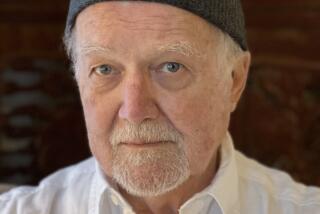How the West was run
DEANNE STILLMAN loves the desert. It is, she writes, “my beat and my passion,” a place where city life fades away, her thoughts vanish and she hears things: “The beating of wings. The scratching of lizard. The crack of tortoise egg. The whisper of stories that want to be told.” Her 2001 book, “Twentynine Palms: A True Story of Murder, Marines, and the Mojave,” told one of those stories, of the violent murder of two local girls who had been “sliced up” by a Marine in the desert. In the course of writing that book, a story of slaughter in the high country outside Reno grabbed her attention. It was December 1998; this time there were three murderers, two of them Marines (one stationed at Twentynine Palms), and the victims were wild mustangs, 34 dead in several killing sprees.
Shaken by the similarities between the killings, Stillman wondered why someone would kill the animals that had blazed our trails, fought our wars, served as our loyal partners? Was there something about the slaughter of wild horses that went straight to the heart of who we are as Americans? “With all due respect to our official icon, the eagle, . . . “ she writes, “It is really the wild horse, the four-legged with the flying mane and tail, the beautiful, bighearted steed who loves freedom so much that when captured he dies of a broken heart, the ever-defiant mustang that is our true representative, coursing through our blood as he carries the eternal message of America.” She began to wonder about the men who shot them: “Were they modern Ahabs? Or . . . just a bunch of drunks with guns? Or perhaps they were a strange new iteration of the American psycho, or maybe even some full-on combination platter of all of the above.”
These questions led Stillman into an impressively thorough, painstakingly researched investigation of the history of the horse in North America. She began by hiking into a remote canyon in Death Valley, where the climatic conditions have preserved in stone the hoof prints of the modern horse’s most distant ancestors. These small horses had flourished here millions of years ago, until the Ice Age, when horses disappeared from North America, “but not before they had headed north across the Bering land bridge and populated the rest of the world.” Not until the early 1500s did horses return to the continent, when Hernando Cortes brought shiploads of them from Cuba, correctly assuming that they would give him the advantage he needed to conquer the Aztecs.
From the jungles of Central America, horses moved north, carrying Catholic priests and tribal scouts across the Rio Grande and into the wild country of the great Southwest, all the way from Texas into California. Horses broke away from war parties and missions, turned wild, formed bands and flourished in this unfenced, endless land. There were so many horses in the early 1700s that the maps drawn of Texas at the time marked the territory between the Rio Grande and the Nueces River not as a place but as “Vast Herds of Wild Horses,” or simply “Wild Horses.” By the 1840s, Texas ranger John C. Duval reported seeing “a drove of mustangs so large that it took us fully an hour to pass it, although they were traveling at a rapid rate in a direction nearly opposite to ours.”
From the Southwest, Stillman follows the horses onto the Great Plains, where they were stolen, or caught and tamed, by Native Americans, “forming a partnership that seemed as old as forever.” They became the most valued asset in the Indian Wars, during which they were also pressed into service by the U.S. Cavalry. Stillman tracks the famous war horse Comanche from his birth in 1862 in the Texas desert to the Battle of the Little Bighorn, where he was found standing silently, riddled with bullets, near his fallen rider and was celebrated as the only surviving member of Custer’s campaign.
SHE TRACKS the horses along the Goodnight-Loving Trail, where they became the cowboy’s hardworking companions on cattle drives; across Utah and Nevada, carrying riders of the Pony Express; and finally into show business. First into Buffalo Bill Cody’s internationally famous traveling show, which turned the gruesome Indian Wars of the Great Plains into a kind of carnival, and eventually to Hollywood, where the first motion picture ever was of a horse running. It was shot with a dozen still cameras firing in sequence, their shutters tripped by the wheels of a sulky pulled by a trotting horse. “Once again,” Stillman writes, “the country embarked on a great transformation, all because of the horse -- which in this case had taken its own picture.”
In devoting 10 years of her life to the writing of “Mustang,” Stillman joins those crusading women -- among them mustang advocate Wild Horse Annie (who said, “A woman can go far with a girdle and a can of hair spray”) -- who believe that one person can effect positive change in the world. Like the best nonfiction writers of our time (Jon Krakauer and Bruce Chatwin come to mind), Stillman’s prose is inviting, her voice authoritative and her vision imaginative and impressively broad. One cannot read “Mustang” in its entirety without realizing that it is possible to look at every single transformative event in North American culture through the lens of equine history -- that there is no way to even consider the history of the American West without first considering the horse.
Perhaps what is most interesting about this intelligent and lovingly assembled account is Stillman’s illumination of the psychology behind our conflicted feelings about the horse. “[T]he horse’s ability to provide flight was universally desired, and nowhere is this desire more pronounced, more extreme, than in America, where escape and the chance to start over is not a pipe dream, but a birthright,” she writes. “[W]e worship cowboys and we’re jacked on freedom and we love moving fast through wide-open space, preferably on a cactus-lined highway in our most iconic car, the Mustang, whose grill features a galloping pony.” The Marines who shot the horses in the desert, Stillman suggests, may have been experiencing feelings akin to those of the protagonist of “Equus,” who falls deeply in love with horses and then, in “an ecstatic frenzy,” blinds six of them: “The horses have roiled the young man, stirred his juices, mirrored his wild side and even stoked it. But they have also seen his shame and must be destroyed.” Perhaps the wild mustang reflects back to us, too keenly, our loss of freedom. “[T]he horse is our great silent witness. . . . [H]e knows too much, and we can’t take it.”
Sentimiento was what the early vaqueros called it when a captured horse died of heartbreak. Despecho meant he had died of nervous rage. For native North Americans, the words “horse” and “power” are nearly synonymous, and for thousands of years people of all cultures have tried to harness that power for their own. What, Stillman’s invaluable history seems to be asking, will it say about us as a culture if we manage to extinguish the mustang’s fire once and for all? *
More to Read
Sign up for our Book Club newsletter
Get the latest news, events and more from the Los Angeles Times Book Club, and help us get L.A. reading and talking.
You may occasionally receive promotional content from the Los Angeles Times.






